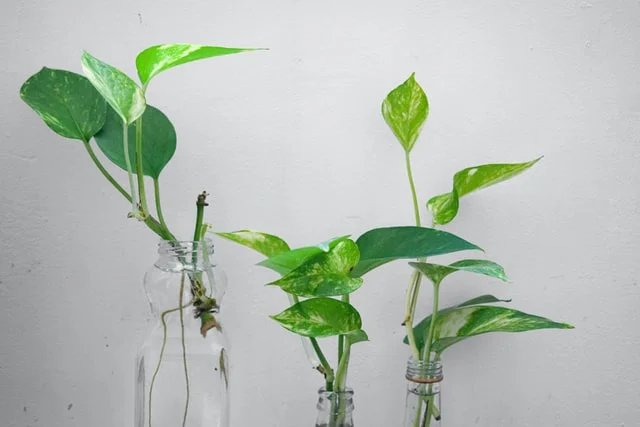Root rot is a horrible thing. It can turn your plants from healthy green beings into horrid, dried-up specimens. But how can a plant that can survive in water get root rot?
In plants like Pothos, root rot can be caused by fungal infections and too much water. Not only does the plant look terrible, but it also prevents it from being able to absorb water and nutrients.
You can solve the issue by cutting off the rotten roots, keeping the plant healthy, knowing how to kill pests, keeping it away from manky plants, and killing any bugs the first chance you get.
Table of Contents
Why it’s bad
It looks ugly
The first reason why root rot is not good is that it makes the plant look terrible. And yes, I know this might not seem like a significant reason, but it does matter because looks do matter when it comes to plants.
If you ask most plant parents why they keep plants, I’m sure there will be at least some who say that it’s simply because they “look nice”. If you’re keeping plants because you want them to bring a bit more life into your home, surely you’ll want plants that look… alive.
The plant can’t absorb anything
Not only will your plant look terrible, but they will also feel terrible. The roots enable your plant to absorb the water and the nutrients that they need to survive. When the roots have become rotten, they won’t be able to absorb any of it.
Instead of being used as a straw, the roots will simply collect the moisture that the plants can’t get, and since it’s just laying stagnant, the water will soon attract more mould.
Think of it like if someone were to sew your mouth shut. You wouldn’t be able to eat, and you would soon starve to your death.
You need to sort it out
Although root rot does not mean it’s game over and you’ve just failed as a plant parent, it does mean that you’re going to have to put in extra time to get the problem sorted.
Most of us don’t have the time to care for our plants like they’re a sick puppy. The time we’re spending on fixing issues such as root rot is time we’re not spending on growing new plants or watching our favourite tv shows.
Solving problems is part and parcel of looking after plants. But it’s still annoying when they occur.
Causes of Root Rot in Pothos Plants
Fungal Infections
One of the most likely causes of root rot in Pothos is some kind of fungal infection. These are incredibly common in wild plants, where they’re exposed to the rest of nature. However, in houseplants, they are slightly rarer- but not impossible.
Fungal infection occurs when fungal spores from something else manages to find their way into your plant’s soil. This might be the shop’s fault- if they were on special offer, there is probably a reason for it. But you can also unknowingly carry fungal infections to your houseplants.
Another common carrier of fungal infections is bugs. Even the common housefly can carry tiny spores on its feet.
Over Feeding
Another common cause of root rot in Pothos is from a high concentration of nutrients. As I’m sure you’re aware, when you keep any plant, you will need to make sure it has enough nutrition. Without nitrogen, your plant will not have the necessary tools to repair and replenish its cells.
However, when the concentration of nutrients is too high, they won’t all fit in. Think of nutrients like people and the cell membranes like a door. If lots of people try to fit through a small door, most of them won’t get inside.
NOT Water
Root rot in Pothos is different to root rot in plants such as snake plants. Pothos can thrive in water, whereas snake plants can easily be overwatered. When a snake plant is experiencing root rot, the most probable cause is too much water.
However, whilst snake plants are adapted to drier climates, Pothos is fine in most places. Some people might tell you that root rot is “always” caused by too much nutrition. But this is not the case.
Solutions
Cut off the bad roots
When your plant is experiencing root rot, if you manage to catch it in the early stages and it’s caused by a fungal infection, the best solution could be to simply cut off the bad roots.
By cutting the bad ones off right away, you will be preventing the infection from spreading to the rest of the plant. Just make sure to always use sharp and clean tools whenever you cut any part of any plant.
When you pick your plant up if the issue is only with one root, that’s a sign it’s still early and easy to sort out.
Change Pot
However, if you notice that all or most of the roots have become victim to root rot, cutting the “bad ones” off will mean cutting all of them off and killing the plant. At this stage, the best thing to do would be to move it to a new pot.
Firstly, brush off any remaining soil from the roots. Then, place it into a new pot with a bit of soil at the bottom, ensuring the new soil is much less nutritionally dense than the old soil. Place your plant in and fill up the rest of the pot.
From here, it may take a few weeks for the root rot to go away.
How to avoid root rot
Keep it healthy
Once the root rot has gone, your next challenge will be to avoid having it happen again. One of the best ways to do this is to keep it healthy.
When your plant is healthy, its immune system will be better suited to combat any more threats that might come its way. You can keep it healthy by watering it, giving it enough (but not too many) nutrients, ensuring it gets enough sunlight, and keeping the temperature stable.
Feed it less
If the issue last time was overfeeding, you will need to feed it less often. But as we’ve already mentioned, you will still need to feed it sometimes.
How often you should feed will depend on several factors, including temperature, size, and drainage ability of the soil.
However, generally speaking, it would be wise to feed it between 1 to 4 times a year. If you’re keeping it in water, you may need to feed it every month or so since you’ll be pouring away nutrients when you change the water.
Just like with people, feeding the Pothos is good. But overfeeding the Pothos is bad.
Keep away from bad plants
If the cause of the root rot was a fungal infection, it could have been passed on from another plant. This issue is much more common in the wild, but if you like to keep all of your plants close together, the chances of problems spreading from one plant to another increases.
If one plant is a bit manky, it will be a matter of time before the issue spreads to the other plants. So as soon as you notice an off plant, you will need to quarantine it and only bring it back with the others when you’re confident it’s better.
Kill bugs
Since pests are also another key spreader of fungal infections, it can be wise to take action against them. The three best methods are bug spray, soap and water, and rubbing alcohol.
With the spray, just give your plant a couple of squirts, and bugs will keep clear. Dish soap and water will create a barrier that no bug will be able to attach to. They will soon give up and fly away.
Rubbing alcohol is, as the name suggests, a kind of alcohol. Imagine what a shot of tequila can do to you. Now imagine what something with a 30% higher ABV will do to something one-millionth the size of you!
Propagation: The final solution
If you’ve tried all of these methods, and your Pothos still won’t shake off its root rot, does this mean it’s game over?
Not necessarily. The game hasn’t finished. It just needs to be restarted.
So long as there is still one healthy leaf left, you still have a chance. By doing propagation, your last leaf will grow into a new beautiful plant.
Place the leaf in a small pot of water for a few weeks to allow roots to sprout. Then, move it to a bigger pot and keep upsizing the pots as the plant gets bigger.
Conclusion
And that is how you solve root rot in the Pothos Plant. Root rot is not as much of an issue with Pothos as it is with the Snake Plant. And the causes will often be very different.
When your plant gets root rot, it can feel very frustrating. It can even make you feel as though you’re not a very good plant parent. However, if you follow these simple instructions, you still have a chance of salvaging your plant. And if that fails, you can always start again from Stretch via propagation.
Photo by Mahdi Dastmard on Unsplash


